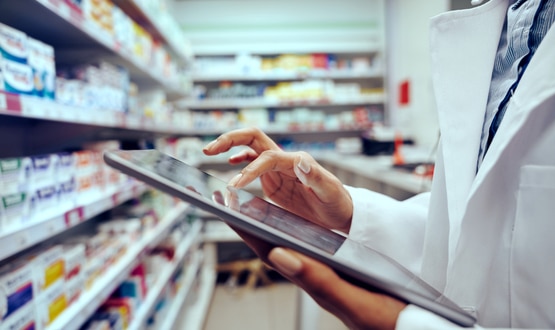Implementing an ePMA at pace during a global pandemic
- 6 July 2021

John Gwilliam qualified as a pharmacist in 2005 and has been an NHS hospital pharmacist since 2012. He joined Wye Valley NHS Trust in December 2019 taking on the role of lead digital pharmacist and played an integral role in the project team that successfully implemented an electronic prescribing and medicines administration (ePMA) solution within the trust in just six months. In a blog for Digital Health, he shares the factors that he feels led to their success.
At Wye Valley NHS Trust (WVT), we provide community services and hospital care to just over 180,000 people in Herefordshire and Powys, while also providing urgent and elective care to more than 40,000 people in mid-Powys, Wales. Like many trusts, we have relied on paper-based prescribing processes, which are based on an original model that has been running for decades. We have approximately 500 medical and 100 non-medical prescribers hand writing prescriptions for inpatients and outpatients across our sites, which includes three community hospitals. Prescriptions are then delivered by hand, air tube, or in the case of the community hospitals, by scanned and emailed copies. This system just isn’t fit for modern healthcare and there are far too many opportunities for error. As such, the decision to switch to electronic prescribing and medicine administration at WVT was easy and the board made it a priority as part of the wider digital transformation strategy. But then the Covid-19 pandemic hit.
Our implementation was initially put on hold as the trust stopped non-essential work to prepare for, and treat, Covid patients. So when we were able to reinstate the project, we knew that we had to move forward with our implementation as quickly, but as safely, as possible. We first gained access to the Better Meds ePMA system in March 2020; within six months we had gone live on our pilot ward and we have now rolled out across approximately 95% of the trust’s inpatients including paediatrics and ITU.
Working with staff
I think the single most important factor in our success was that we worked with staff across the trust to understand their needs and ensure that EPMA worked the way they needed it to. Also, WVT was committed to the project at a senior level with the clinical director of pharmacy, the financial director, the medical director, and the nursing director all sitting on the project board.
Staff engagement was a real priority and not just a tick box – we made a point of speaking to end users to understand their needs, letting them trial the system and gathering feedback. We also held roadshows to resolve any misconceptions and challenge any myths that were circulating. This created a team atmosphere and generated ownership so that ePMA wasn’t something that was imposed on staff; they were active collaborators in the project. This had added benefits in that when we experienced challenges, which you always do when implementing a system such as an ePMA, there was a sense of camaraderie and staff cooperated to solve them. For example, during our rollout on intensive care, there were challenges faced around the prescribing and administration of enteral feeds for patients on the unit and a solution was found within the hour by discussing options with the clinical team and working through configurable solutions with stakeholders there and then.
Facing challenges
There were other challenges, for example, a new hospital building under construction, wards merging and moving to allow safe management of Covid positive patients, and we were unable to launch on one of our pilot wards as planned due to another IT project going live at the same time. In this last example, we shortened our pilot go-live by a week each to keep on schedule and ensure the delays wouldn’t impact other planned rollouts. In the end, we had seven go-live scenarios due to the various challenges that we faced along the way.
Another issue was staff training, which would normally happen face-to-face. We had to move training online, which while it gave staff the autonomy and flexibility to learn about the system at a time convenient to them, it ran the risk that they wouldn’t complete the training ahead of implementation on their wards. We tackled this by incentivising engagement by getting the nurse training course accredited with the Royal College of Nursing. This gave nurses a nudge to complete the training, even from home, as they knew they would have a certificate for revalidation. The movement of training to an online platform freed up project staff who would have been involved only with training, to engage in a more holistic approach to ward readiness and focus on understanding and support as opposed to rattling through training session after training session.
Again, during roll-out, we made sure that we spoke to staff and were available whenever they needed help. We were on-site from 8am until 10.30pm and then had an on-call system outside of this so that support was, and remains, available 24/7. This made sure that our staff felt supported and reassured that they would have the help they needed whenever they needed it.
While there was a lot of work that went into the planning and processes, it really is the relationships and this element of our implementation team being present and accessible that has made the roll-out a success and enabled us to hit the project milestones.





5 Comments
The move to get the training course accredited with the RCN was a brilliant move.
Agree
Agree too, though Nurses are generally more compliant with completing training in a timely manner as opposed to other health care professions. What ‘nudge’ did the trust employ to get your doctors to complete their training on time? Also, what online training resource did you use and would you change anything post-go-live?
The RCN accreditation for nurses really did help. I have found the promise of an hour back does not nudge the nurse to complete training due to the struggle they have to take the time they are owed anyway, that plus it is a costly exercise, one which is often hard to have acceptance on. The RCN accreditation was something tangible they could really benefit from, as a nurse myself, evidence of CPD and help towards revalidation can go a long way.
Doctors were tackled in a number of ways, firstly our Medical Director and the areas Clinical Directors were engaged from day 1 and had a high interest in the project, this meant that we had a top down approach to disseminate the need to train. During roll out we also made the decision to recruit a junior doctor to work locum shifts on a Saturday for 6-8 weeks, supporting the on-take teams to (a) transcribe medication (b) undertake regular on call duties whilst the on call trained.
There were a number of other similar measures across the board, ideas i have taken from implementation to implementation. Post the Wye valley roll out, John and I presented at the Clinical Pharmacy Congress – and created a small lessons learnt/implementation guide which can be found below.
We have found shared learning can be of one of the greatest benefits to Trusts implementing EPMA!
Stefan Siekierski
https://info.better.care/en/how-to-go-live-with-epma-in-six-months
Comments are closed.